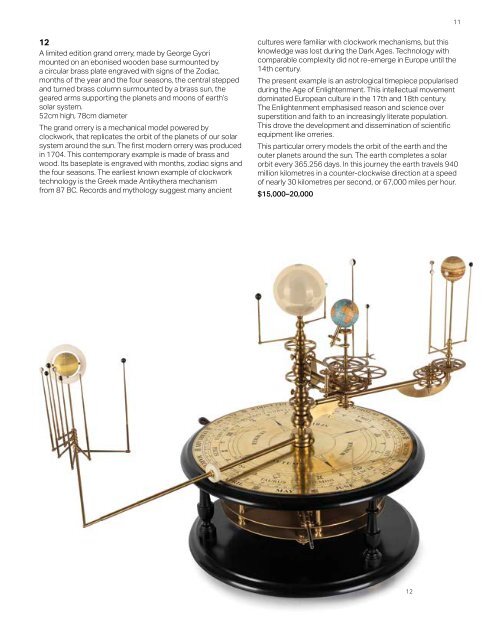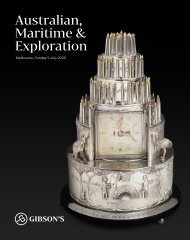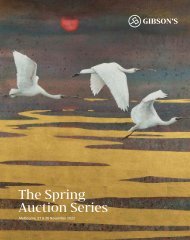GA026 - Tempus Fugit: The Collection of George Gyori | Australian, Maritime & Exploration
Create successful ePaper yourself
Turn your PDF publications into a flip-book with our unique Google optimized e-Paper software.
11<br />
12<br />
A limited edition grand orrery, made by <strong>George</strong> <strong>Gyori</strong><br />
mounted on an ebonised wooden base surmounted by<br />
a circular brass plate engraved with signs <strong>of</strong> the Zodiac,<br />
months <strong>of</strong> the year and the four seasons, the central stepped<br />
and turned brass column surmounted by a brass sun, the<br />
geared arms supporting the planets and moons <strong>of</strong> earth’s<br />
solar system.<br />
52cm high, 78cm diameter<br />
<strong>The</strong> grand orrery is a mechanical model powered by<br />
clockwork, that replicates the orbit <strong>of</strong> the planets <strong>of</strong> our solar<br />
system around the sun. <strong>The</strong> first modern orrery was produced<br />
in 1704. This contemporary example is made <strong>of</strong> brass and<br />
wood. Its baseplate is engraved with months, zodiac signs and<br />
the four seasons. <strong>The</strong> earliest known example <strong>of</strong> clockwork<br />
technology is the Greek made Antikythera mechanism<br />
from 87 BC. Records and mythology suggest many ancient<br />
cultures were familiar with clockwork mechanisms, but this<br />
knowledge was lost during the Dark Ages. Technology with<br />
comparable complexity did not re-emerge in Europe until the<br />
14th century.<br />
<strong>The</strong> present example is an astrological timepiece popularised<br />
during the Age <strong>of</strong> Enlightenment. This intellectual movement<br />
dominated European culture in the 17th and 18th century.<br />
<strong>The</strong> Enlightenment emphasised reason and science over<br />
superstition and faith to an increasingly literate population.<br />
This drove the development and dissemination <strong>of</strong> scientific<br />
equipment like orreries.<br />
This particular orrery models the orbit <strong>of</strong> the earth and the<br />
outer planets around the sun. <strong>The</strong> earth completes a solar<br />
orbit every 365.256 days. In this journey the earth travels 940<br />
million kilometres in a counter-clockwise direction at a speed<br />
<strong>of</strong> nearly 30 kilometres per second, or 67,000 miles per hour.<br />
$15,000–20,000<br />
12


















